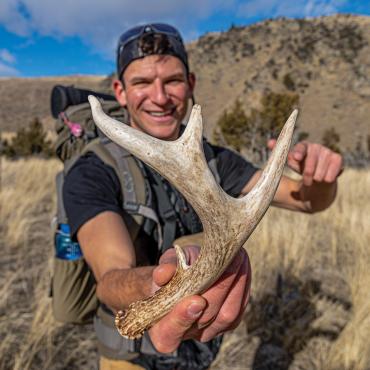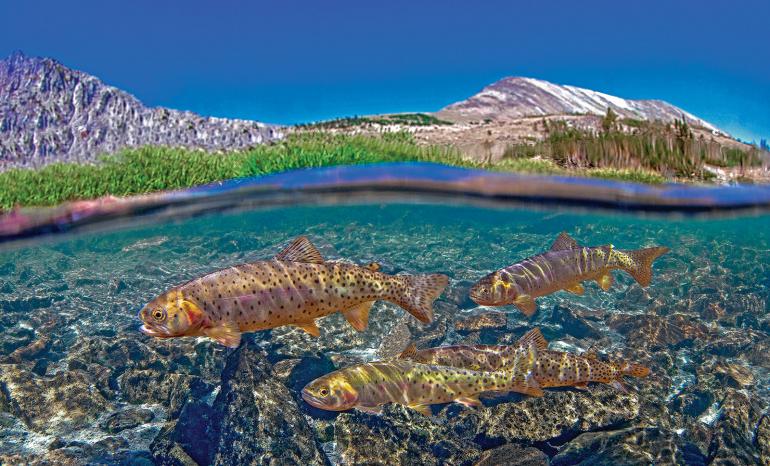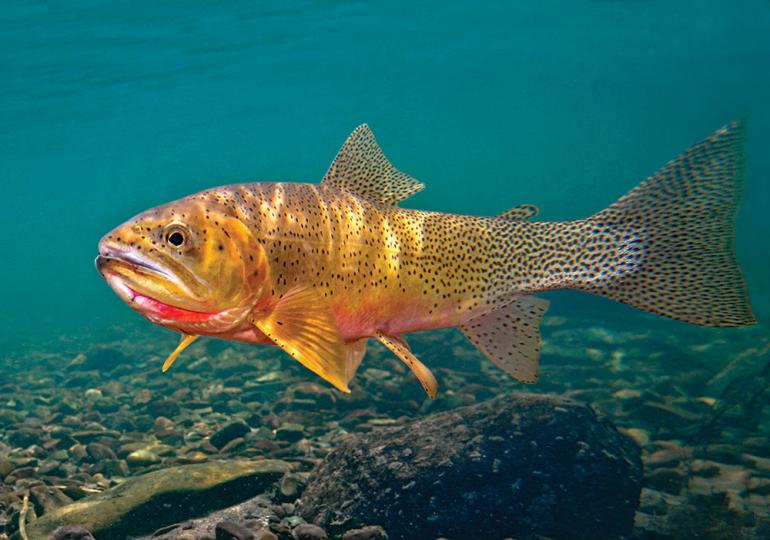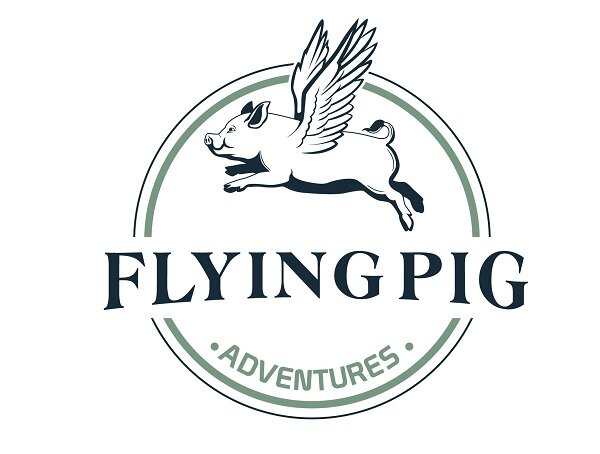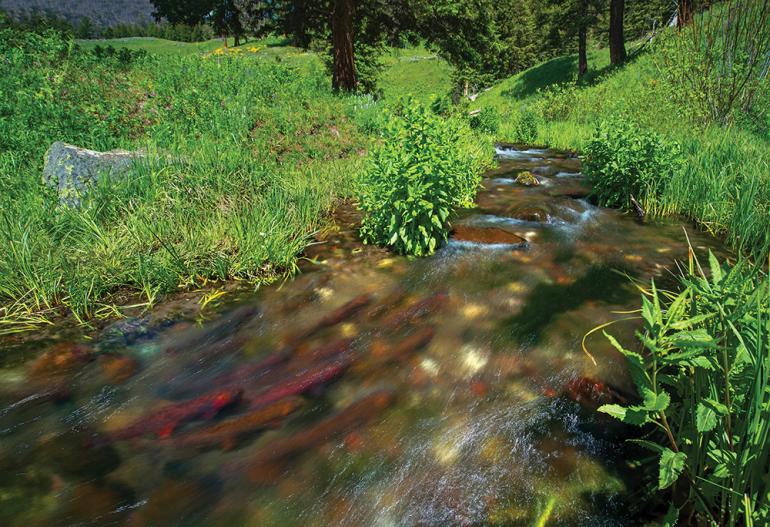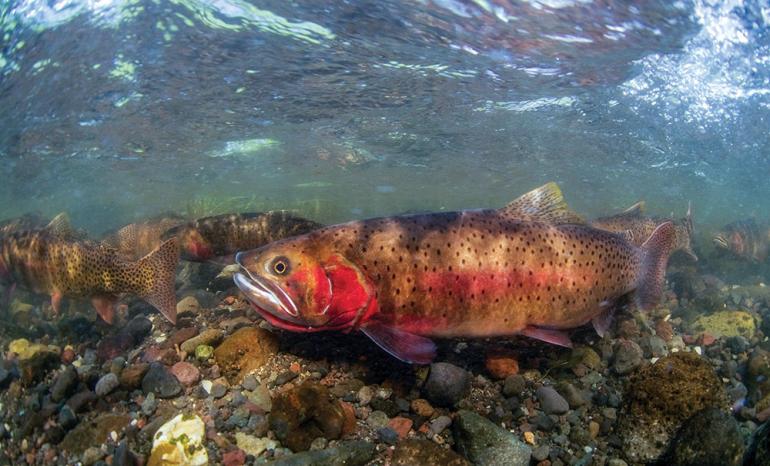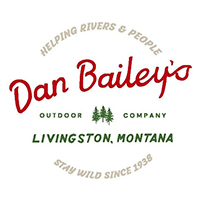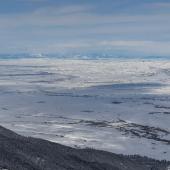Cutthroat Crusades
The challenge of native-trout conservation.
Fisheries biologists in southwest Montana have been leading the charge to protect native cutthroat trout, one of the state’s most beloved aquatic species—but not without setbacks. Successful projects must overcome the daunting tasks of fundraising, garnering public support, and putting enough boots on the ground to be effective. With warming waters accelerating the urgency of conservation efforts, the race is on to establish permanent refuges for westslope and Yellowstone cutthroats. Two state projects—one just up Gallatin Canyon, and another in the northeast corner of Yellowstone Park—reflect the challenges involved.
Success in the Spanish Peaks
On a crisp August morning on Ted Turner’s Flying D Ranch, dozens of wader-clad biologists mill about a large manmade concrete waterfall. They chat in small groups and sip coffee from thermoses plastered with fish stickers. Faces are weary, but there’s an excitement in the air as they gear up for the last day of what has been a nearly 10-year effort to secure 17 river-miles of the North Fork of Spanish Creek as the only native westslope cutthroat trout sanctuary in the Gallatin watershed.
While bearing semblance to a submerged handball court, the half-million-dollar cement behemoth is the critical component of the project. It’s a series of carefully constructed cascades, designed to prevent the upstream movement of non-native fish into the upper reaches of Spanish Creek. Building a barrier such as this is the first phase in a project of this kind.
The biologists are there to assist with the second phase: using a plant-derived piscicide called rotenone to kill fish—native and non-native alike—from the barrier upstream to where Spanish Creek seeps out of the Spanish Peaks. While the poison is indiscriminate, it is the only way to ensure the complete eradication of non-native fish. All it takes is one remaining pair of breeding brook trout, or a single rainbow trout capable of hybridizing with cutthroat trout, to compromise the integrity of the project. Like a football coach before a big game, Carter Kruse, the director of conservation for Turner Enterprises, gives the biologists a quick pep-talk on the importance of being thorough and liberal when applying the rotenone. The meeting breaks, and the biologists break away in pairs, taking off in trucks and ATVs to disperse across the last section of stream slated for treatment.
While it’s uncommon for fisheries-restoration projects to occur on a mix of public and private lands, the Spanish Creek project is a unique and exemplary case. Kruse recognizes that while nearly half the project is on the media magnate’s land, it was an interagency cooperation from the start. “You have to sit down around the table and make sure you’re all on the same page,” Kruse says, referring to the joint fundraising, planning, and labor effort shared between Montana Fish, Wildlife & Parks (FWP), the US Forest Service, and Turner Enterprises. Kruse explains that this public-private interface could actually be beneficial to the overall resilience and health of the fish. “Having a diversity of habitats and a diversity of management is more secure than having all your eggs in one basket,” Kruse says. National Forest lands on the upper end of Spanish Creek face different pressures—angling, horsepacking, fire suppression—than the land managed by Turner. Additionally, constructing the fish barrier on private land minimizes the risk of unscrupulous members of the public, or so-called “bucket biologists,” threatening the effort by moving non-native fish around the barrier.
The third and final phase is restocking native westslope cutthroat trout. Protected by the barrier from competition with rainbow, brown, and brook trout, this new cutthroat population will have the potential to thrive in the cold, pristine waters of Spanish Creek.
Which raises broader questions about cutthroat conservation in Montana. If protecting one of our most beloved native-trout species requires humans to plant them into isolated enclosures, what does the future look like for these fish? Concrete barriers need to be maintained for perpetuity, and despite our best efforts, these secluded populations are still subject to lethal diseases and catastrophic wildfire events. For better or worse, non-native sport-fish species in the Gallatin River and other nearby waterways are here to stay, and mitigating their impact is going to take even more meddling on our end. We poison fish, replant fish, and move them around to the point where we can’t help but wonder what a native, wild population even means. Moreover, progress is slow and hard-earned. If it weren’t for the toil of biologists and the receptivity of landowners in southwest Montana, cutthroat would likely be in even greater peril. “I’m happy that we were able to come together to accomplish mutual goals and make a measurable difference for westslope cutthroat trout in southwest Montana,” Kruse says. “That’s ultimately what’s most important.”
Turmoil on Buffalo Creek
On the other side of the Gallatin Range and across Paradise Valley, a huge reintroduction effort is in the planning process on a tributary of Slough Creek—perhaps the most iconic Yellowstone-cutthroat trout stream in the Greater Yellowstone Ecosystem. It’s hard to imagine a more picturesque waterway: meandering channels commingle with luscious meadows and beaver-dam complexes, forming prime habitat for cutthroat trout eager to slurp an angler’s dry fly.
While the landscape seems untouched from above, below the water’s surface the story is more complicated. Native Yellowstone cutthroat trout are facing two compounding threats: climate change and the potential for hybridization with non-native rainbow trout. Climate models predict up to a 30% decline in the amount of suitable cutthroat habitat over large swaths of Slough Creek and its tributaries by the year 2080. Warming water not only pushes cutthroat trout farther into headwater creeks, often located in Wilderness Areas, but also allows rainbow trout to flourish in areas that were once too cold.
In a landscape where it is almost impossible to escape the impacts of humans, it seems reasonable to leave our last handful of truly wild places as untouched as possible.
In the Slough Creek drainage, biologists have determined that the main source of rainbow-trout encroachment is from Buffalo Creek, a 60-mile-long tributary that flows south from the heart of the Absaroka-Beartooth Wilderness. It was historically fishless, due to a large waterfall near the Yellowstone boundary; but rainbow trout stocked in a mountain lake at the headwaters of Buffalo Creek in 1935 have gradually trickled out of the lake and are now present throughout the watershed. A joint effort between Montana FWP, the US Forest Service, and the National Park Service plans to eradicate non-native trout from the upper 47 miles of the Buffalo Creek drainage, replacing them with a population of Yellowstone cutthroat trout.
Bryan Giordano, the lead biologist, is excited about Buffalo Creek’s unique possibility. “It’s incredible to have the opportunity for a secure population, and in a climate shield,” says Giordano, referring to sections of water that scientists predict will remain cold enough to support cutthroat trout for at least the next 50 years. “It’s a two-prong deal,” he adds. “It seems to be rare to have these kinds of opportunities to really have that impact.”
The project has nonetheless faced delays, due to the administrative processes required for approval. While initially held up by changes within the FWP Fish & Wildlife Commission, the main obstacle now is processing the nearly 15,000 public comments responding to the draft Environmental Assessment published in March 2021. Under the proposal, biologists plan to use rotenone to kill all fish in the project area over the course of two weeks in late August across multiple consecutive years, until the area is deemed fishless. While originally slated to begin in 2021, the timeline has been pushed back and Giordano now expects it to take place in 2022 and 2023. The application of rotenone will require the use of horsepack strings, helicopters, and motorized boats to assist with spraying and dripping the piscicide into nearly 50 stream miles, 25 acres of wetlands, and two high-mountain lakes located inside the Absaroka-Beartooth Wilderness boundary; this will require the Forest Service to grant a motorized-use exception for the project.
The conservation community is watching, and so are generations of future anglers.
Kevin Proescholdt, conservation director for Wilderness Watch and a main opponent of the project, says that the proposal doesn’t fit the criteria required for granting a motorized-use exception. “We shouldn’t be manipulating Wilderness Areas now to create places where fish never historically or naturally existed,” Proescholdt says. According to the Wilderness Act of 1964, the Forest Service is tasked with the responsibility of preserving Wilderness Areas in their “natural condition,” which Proescholdt believes is fundamentally at odds with replanting a species that didn’t historically exist in the stream. While focused on the context of fish, Proescholdt is getting at the deeper question of what Wilderness Areas should be preserved for. In a landscape where it is almost impossible to escape the impacts of humans, it seems reasonable to leave our last handful of truly wild places as untouched as possible. If the project goes through, Proescholdt is understandably worried that it will set the precedent of sacrificing the undisturbed character of Wilderness Areas for the sake of fish-and-wildlife conservation.
On the other hand, Wilderness Areas might be our last hope for protecting sensitive species from our own destruction. While cutthroat may not have ever been present in the Buffalo Creek drainage, they are ubiquitous throughout the rest of the Absaroka-Beartooth Wilderness, including the famous Hellroaring and Slough creeks. Giordano notes that as the climate changes, “we are going to have to look to some of these places to expand cutthroat populations.” As warmer water reduces the range of native-fish species in Montana, the decisions made now will not only set a precedent for future efforts, but also determine the fate of Yellowstone cutthroat trout that have inspired generations of anglers and conservationists. “This project has been in the works for almost a decade, and our team thinks it’s our best chance to safeguard these fish into the future,” Giordano says, referring to the tremendous amount of interagency cooperation required to complete a project of this caliber.
The Fish & Wildlife Commission has already approved the rotenone treatment, and biologists plan to release a final Environmental Assessment this spring, in conjunction with the Forest Service’s decision to grant a motorized exception. The conservation community is watching, and so are generations of future anglers.

